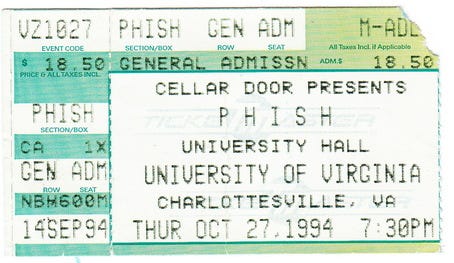
If I asked you to name the most-played songs in fall 1994, you’d likely pick the old chestnuts (YEM, Reba, Tweezer) or one of the newer songs getting heavy rotation (Guyute, Simple, the bluegrass Foreplay/Long Time). Without peeking at phish.net — or the title of this blog post — it’d probably take a lot of guesses before you got to Vibration of Life. Barely a song, really, this track appeared an impressive 11 times in the tour’s 46 shows, never disappearing for more than four shows after its tour debut on 10/23.
Tonight’s Vibration of Life is the second one in as many shows (Phish heresy!) and the third in four nights; it will soon turn up again, memorably, as part of the Halloween Harpua. Its eleven performances in fall 94 are fully half of its appearances to date, all of which fall within the four years between 11/23/92 and 11/19/96. Mostly, it appears in YEM, where the early ambient section is prime territory for a digression about sound waves, but it also serves as one of Trey’s recurring story beats for narrations in Harpua and Forbin’s > Mockingbird.
The “song” is typically just a drone produced by Trey and Mike, with Trey explaining a mish-mosh of wave physics, psychoacoustics, and the purported physical effects of binaural beats over the top. The vibration of the title is always 7 to 7.5 beats per second, it’s often described as the “universal life force,” and promises benefits such as higher energy, greater connectivity to the surrounding world, and occasionally, when combined with NO2, a lighter nose and heavier eyes.
Functionally, The Vibration of Life works like a less-scripted version of Kung or Catapult (fans got all three in a row on 11/16/96), or even mantras such as Lengthwise or Ass Handed. They’re more like incantations or ceremonies, sometimes deployed over especially avant-garde stretches of improvisation, or as an accelerant in sets that are already veering into madness. There’s a bit of cultish mythos-building to these pieces as well — Trey often asks “how many of you have heard of the vibration of life?” like a street preacher asking if you’ve heard the good word (on one occasion, Trey gives songwriting credit to God himself). It’s in the same ballpark of “you’re in on the joke” signals as a Gamehendge reference or the secret language.
It’s reasonable to assume that all of these weird songish pieces serve slightly different purposes, so what’s the role of The Vibration of Life? Beyond it being a deeply weird thing to do in the middle of a rock show, it’s not obviously a joke. Even after listening to every version available, it’s hard for me to judge how genuinely Trey believes in the scientific jargon he spouts. In the debut version, he says it was inspired by something “Mike was reading the other day,” but even though I’m a science writer by trade, I can’t find any legitimate primary source it was plausibly based on. Maybe it’s as simple as noticing that The Vibration of Life first started appearing not long after their summer with Santana, a man who seems to have no shortage of theories on the mystical and/or scientific abilities of music.
Scientific veracity aside, Trey often says some variation of “this should recharge you with energy for the rest of the show.” So maybe The Vibration of Life was an inside joke, not unlike playing FEFY after a song that was too high tempo, meant to quite literally raise the energy levels of the band or crowd when needed. Or maybe the drone is a signal that they’re overplaying — any musician as talented as the members of Phish has to constantly fight the urge to play too many notes, so let’s take a breath and just focus on one for a couple minutes.

But why the sudden surge of vibrations, life or otherwise, on this tour? Phish is never going to be Sunn O))), and Trey’s hyperactivity will never let them sit on a drone for more than a couple minutes. But 1994 definitely finds the band starting to explore textures of sound more fully. One of the big leaps between 1993 and 1994 is Trey’s occasional use of a much noisier tone, often constructing Frippian anti-solos in Maze or Antelope or BBFCFM. It’s a trend that will continue through the end of the decade, when they’re playing half-hour versions of Sand with 10 guitar loops running simultaneously over an unchanging bass line.
Perhaps the frequency (pun intended) also has something to do with how often Trey explicitly frames VoL as “conducting an experiment,” coming at a time when Phish is starting to implicitly treat shows as large-scale trials. We haven’t gotten there quite yet, but 1994 is a new high water mark for Phish experimentation, and one of the breakthroughs is a willingness to make music that may not be easily accessible or directly pleasurable to the audience. The stranger moments of the Bangor Tweezer or the more frightening sections of the Providence Bowie are far more complex than a seven beats per second, slightly out of phase drone, but the sentiment is the same - let’s see what kind of physical and psychological effects a truly extreme piece of music can have on a mass of people. Eventually, they wouldn’t have to explain the Vibration of Life at all — we’d just feel it.
[Stub from Golgi Project.]


